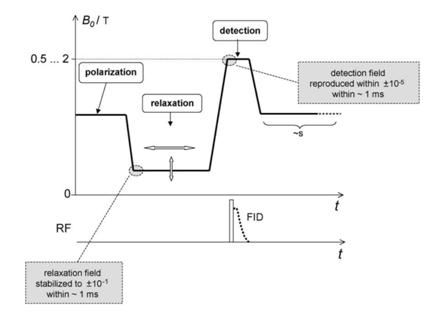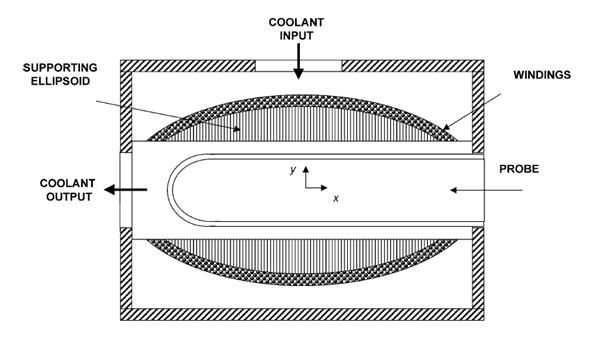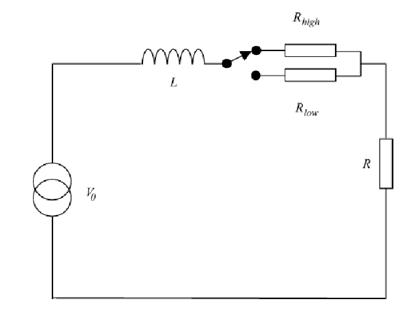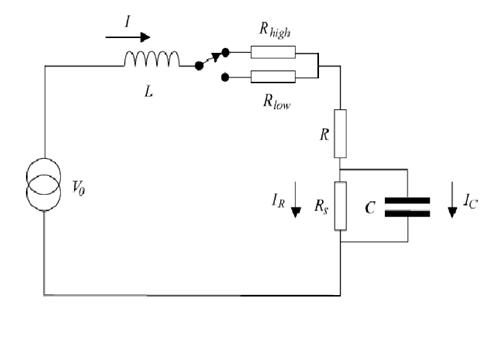Field Cycling NMR
The spin-lattice relaxation (T1) plays an important role in NMR relaxometry and imaging, as it determines the essential properties of the sample, as well as the contrasts of the images. Field-cycling NMR relaxometry is a technique that determines the T1 value of the sample at different polarization and relaxation background magnetic field. The background magnetic field in field-cycling NMR machine can be changed at a lot faster rate than conventional NMR relaxometry. Therefore, the relaxation rate from polarized field to relaxation field can be determined more accurately.

Figure 1. The sharp gradient between different magnetic fields represents a fast changing magnetic field. The sample is polarized at the polarization field, and when the field changes to the relaxation field, the sample will then begin to relax. After a certain period of relaxation, the field is changed to detection field to bring the precession frequency to Lamor frequency for detection. The measurement is repeated using different relaxation period to obtain the longitudinal magnetization (Mz) as a function of time. From this, we can obtain the T1 of the sample. [1]
Superconducting Magnet
The technology of the superconducting magnet plays a vital role in a field-cycling NMR relaxometer. The main benefit of using superconducting solenoid compared to conventional solenoid is that large current can be put into the coil to generate a stronger magnetic field, as joule heating will no longer be a limiting factor in the former case. To change the field at a high rate, large current will be needed to be cycled in and out of the superconducting magnet at an extremely fast rate. Therefore, it is important to minimize the size of the field, while maintaining the same field strength. That could only be done by using a compact solenoid.
However, having a compact solenoid causes many problems to arise, such as field homogeneity and require large sample volume. To solve the field homogeneity problem, the magnet can be designed in a shape of an ellipsoid. (see Figure 2) The superconducting solenoid is also required to be permanently connected to the power supply through copper leads as the field-cycling relaxometry requires frequent changing of field. This leads to the warming of the superconductor due to conduction from the copper leads connected to the power supply, which is at room temperature. Furthermore, the joule heating from the high current travelling through the copper leads also contributes to the heating of superconductor. [1] Thus, the use of superconducting field-cycling relaxometer is relatively expensive, as the liquid helium loses amount to 0.24 litre per hour. [2]

Figure 2. Superconducting coils are winded around the supporting ellipsoid to reduce the magnetic flux density in the middle to make the field homogeneous. Liquid helium is injected to cool the superconducting coil as well as the probe. [1]
Power Supply
In field-cycling relaxometers, the power supply for the magnetic current is also an important component. The power supply has to have the following properties:
1. Short control time constant to enable fast current switching.
2. Able to provide very stable current.
3. High peak power for fast energizing of magnet.
4. Short settling period of the current after reaching desired field strength.
5. Field strength has to be settled at high precision to allow for magnetic resonance and phase sensitive detection.
The above conditions can be met using sophisticated high-powered circuits, such as over-damped and sub-damped resonance circuit. (see Figure 3 and 4 respectively)

Figure 3. Principle of over-damped resonance circuit. [1]

Figure 4. Principle of sub-damped resonance circuit. [1]
Reference:
1. Kimmich R., Anoardo E. (2004) Field-cycling NMR relaxometry. Progr. Nucl. Magn. Reson. Spectr. 44 (2004) 257 – 320.
2. Schauer, G., W. Nusser, M. Blanz, and R. Kimmich. (1987) NMR field cycling with a superconducting magnet. J. Phys. E. Sci. Instrum. 20:43-46.